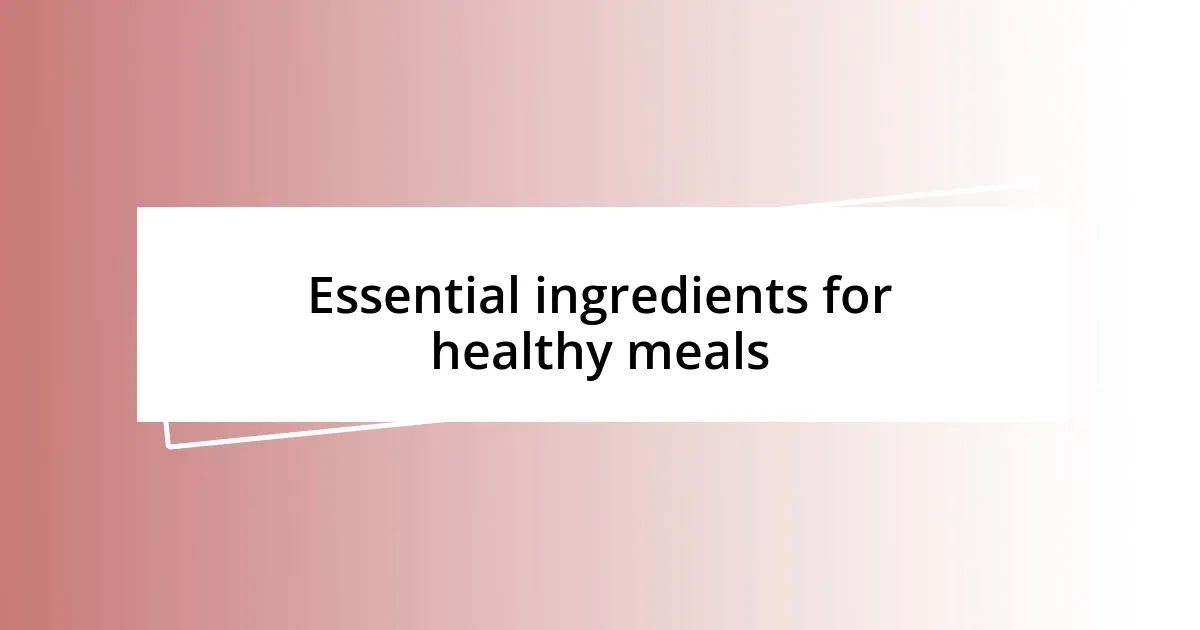Key takeaways:
- The journey into health cooking began with a desire for better energy and well-being, leading to a sense of accomplishment through recipe experimentation.
- Essential ingredients for healthy meals include leafy greens, whole grains, and healthy fats, each contributing unique nutritional benefits.
- Adopting cooking techniques like steaming and roasting enhances flavor and preserves nutrients, transforming meals into nourishing offerings.
- Meal planning and variety play crucial roles in maintaining a healthy cooking routine, helping to manage time and explore new flavors.

My journey into health cooking
When I first started my health cooking journey, it was born from a desire to feel better and have more energy. I remember standing in my kitchen, surrounded by colorful vegetables, feeling a surge of excitement about crafting meals that nourished my body. Can you recall the thrill of preparing something fresh and vibrant for the first time? For me, it was like opening a door to a world filled with possibilities.
As I experimented with new recipes, I often felt a bit overwhelmed. I tried swapping out ingredients I used to reach for without thinking, like replacing white rice with quinoa. Each change was a small leap of faith, and every successful dish was a little victory that fueled my passion even more. Have you felt that sense of accomplishment when you nail a new recipe? That fun thrill kept me going.
The biggest revelation came when I attended a local cooking class focused on plant-based meals. Surrounded by like-minded individuals, I realized I wasn’t alone in my struggle to create healthier habits. Sharing recipes and tips with others brought a sense of community—a reminder that health-conscious cooking could be just as much about connection as it was about nutrition. Remember, it’s not just about what we eat; it’s also about who we share our meals with.

Essential ingredients for healthy meals
When I think about essential ingredients for healthy meals, I can’t ignore the power of leafy greens. Spinach and kale were once just garnishes to me, but now they are my meal staples. Adding these greens not only boosts the nutritional profile of any dish but also gives it a beautiful pop of color. It’s amazing how just one handful can transform a mediocre meal into something vibrant and full of life. Have you noticed how a simple salad can become a centerpiece when you include these greens?
Another essential for me is whole grains. Swapping out refined grains for options like brown rice or farro was a game-changer in my kitchen. Not only do they offer more fiber, which keeps me feeling full longer, but their nutty flavors add depth to my meals. I remember the first time I served a farro salad at a dinner party; my friends were intrigued and pleasantly surprised at how delicious and filling it was. Have you tried whole grains yet? They might just become your new favorite.
Lastly, incorporating healthy fats, such as avocados and olive oil, elevates the taste and health factor of my meals. Healthy fats help with nutrient absorption, so they play an important role in cooking. I still recall the joy of drizzling my homemade dressing made with olive oil and lemon juice over a fresh veggie platter—it was like a culinary hug. What are some of your favorite ways to include healthy fats in your cooking?
| Ingredient | Benefits |
|---|---|
| Leafy Greens | High in vitamins and minerals; adds color and nutrition. |
| Whole Grains | Provides fiber; keeps you fuller for longer; richer flavors. |
| Healthy Fats | Assists in nutrient absorption; enhances flavor. |

Cooking techniques that enhance nutrition
When it comes to cooking techniques that enhance nutrition, I’ve found that methods like steaming and roasting are unlike any others in preserving the health benefits of ingredients. The first time I steamed broccoli, I was amazed at how the vivid green color popped, and the crunch remained intact. It felt almost like I had uncovered a secret way to lock in not just flavor but vital nutrients too. Roasting, on the other hand, transformed sweet potatoes into caramelized bites of heaven, while still maintaining their vitamins. Have you ever experimented with these techniques? They can bring out flavors in ways you wouldn’t expect!
Here are some techniques that I’ve adopted to enhance the nutritional value in my meals:
- Steaming: Retains nutrients that boiling can leach away.
- Roasting: Caramelizes natural sugars while keeping nutrients intact; boosts flavor.
- Sautéing with healthy fats: Using olive oil instead of butter helps absorb fat-soluble vitamins.
- Blanching: Quickly cooking vegetables preserves their color and crunch, plus their vitamins.
- Pressure cooking: This method cooks food quickly while minimizing nutrient loss.
Each cooking technique not only changes the taste and texture of food but also makes it more nourishing. It’s thrilling to discover how a small shift in preparation can elevate a meal from ordinary to extraordinary! Have you ever felt the excitement of transforming simple ingredients into something spectacular with just a technique?

Meal planning for health success
Meal planning has become an essential part of my health journey. I vividly remember the first week I sat down to map out my meals; it felt overwhelming. However, once I got into a routine, I noticed how it eliminated stress around what to eat each day. I now take the time every Sunday to plan out my meals for the week. Do you have a set day for your meal prep? This simple habit not only saves me time but makes grocery shopping much more efficient.
I also find it beneficial to incorporate variety into my meal plans. Instead of sticking to the same old recipes, I try to explore different cuisines or techniques. For instance, last month, I experimented with a Middle-Eastern meal plan that included falafel, tabbouleh, and tahini sauce. It was a refreshing change, and my taste buds danced with delight! Have you ever tried a themed week for your meals? It can breathe new life into your cooking routine and encourage you to try new ingredients.
Lastly, being mindful of portion sizes is crucial. I learned this the hard way when I served myself a heaping plate of pasta; it was delicious but left me feeling uncomfortably full. Now, I focus on balanced plates, often using smaller dishes to help control my portions. Wouldn’t it be nice to enjoy great food without the post-meal regret? Meal planning not only supports healthy eating but also fosters a deeper connection with the food I prepare.

Overcoming common cooking challenges
When it comes to cooking challenges, I’ve faced my fair share, particularly when it comes to time constraints. I remember one hectic evening racing against the clock to prepare dinner after a long day at work. In moments like these, I’ve learned the power of keeping a few pre-prepped ingredients handy—like chopped vegetables or marinated proteins. Do you keep anything on standby? Having these on hand transformed my frantic evenings into smooth sailing.
Another common hurdle is the fear of experimenting with new flavors or ingredients. I used to shy away from unfamiliar spices, unsure how they would alter my dishes. Then, one weekend, I decided to dive into the world of spices by attempting an Indian curry. It thrilled me to taste the rich, layered flavors that unfolded with every bite! Have you ever let go of your hesitations? The experience taught me that stepping out of my comfort zone can lead to culinary breakthroughs, and it was so rewarding.
Moreover, one challenge that many face is the intimidation of healthy cooking when recipes seem too complicated. I remember scrolling through elaborate recipes that made me feel like I needed a culinary degree to succeed. Instead, I opted for simpler, wholesome dishes—like a vibrant quinoa salad packed with seasonal vegetables. It was quick, colorful, and delicious! What simple recipe do you turn to when you’re feeling overwhelmed? Sometimes, breaking it down to the basics can not only simplify the process but also remind us that healthy cooking doesn’t have to be daunting.














